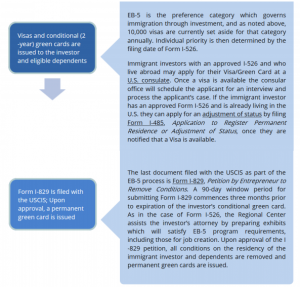The EB-5 Immigrant Investor Program Overview

The EB-5 Immigrant Investor Program (EB-5) was established in 1992 to promote domestic economic growth, improve regional productivity, and create jobs.
EB-5 allows foreign entrepreneurs to invest in jobcreating projects in America. In return, they may receive permanent residency (green cards) for themselves, their spouses, and unmarried children under 21 years of age.
Ten thousand (10,000) immigrant investor visas are reserved each fiscal year by the United States Citizenship and Immigration Service (USCIS) for eligible investors and their families. The families work with their legal counsel and a local Regional Center to fulfill EB-5 program requirements, which include investment in a local commercial enterprise and the creation of local jobs for eligible U.S. residents.
Regional Centers are approved by the United States Citizenship and Immigration Service (“USCIS”) to raise investment capital from foreign entrepreneurs. When invested in a Targeted Employment Area (TEA) or rural area, the minimum investment is $500,000. Outside a TEA or rural area, the minimum investment is $1,000,000.
Regional Centers are authorized to develop new commercial enterprises in a designated geographic area for a specific industry. The Regional Center may then collect, pool, and invest funds from immigrant entrepreneurs. Investment funds must be placed at risk and the enterprise must create or preserve at least 10 full time jobs for qualifying U.S. workers per each immigrant investor.
Achieving permanent residency by investing in the U.S. benefits everyone — immigrant entrepreneurs receive U.S. residency and the right to send their children to an American college, local workers attain or retain good jobs, and the regional economy is enhanced and improved.


